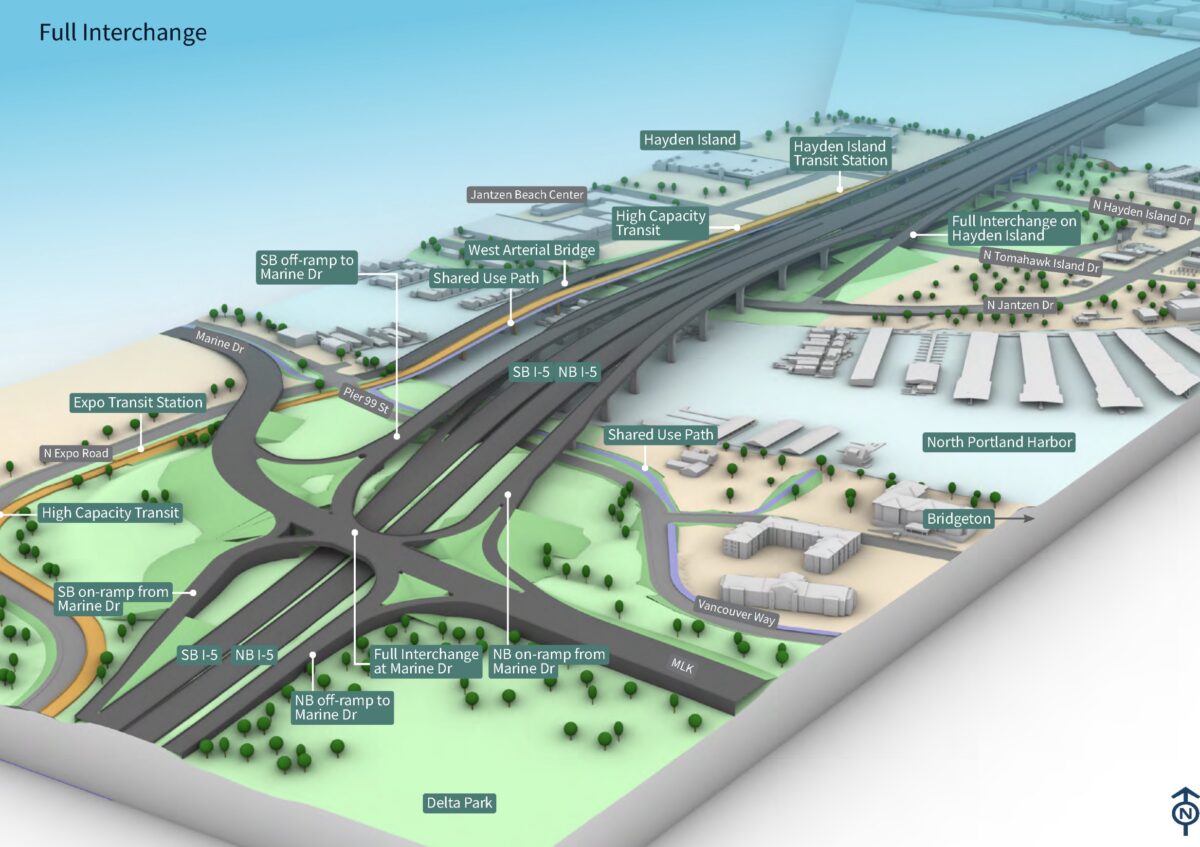Cycling News & Blog Articles
New renderings offer clearest picture yet of Interstate Bridge Replacement project design

Latest rendering of one option for the project as seen looking northwest from Portland. (Source: Interstate Bridge Replacement Program)
Earlier this month, elected officials overseeing the Interstate Bridge Replacement (IBR) project got a look at new renderings showing what a remade I-5 could look like on Hayden Island and its connection to the rest of Portland.
Within the last few months, the IBR has taken all but two alternatives for interchanges on the mainland Portland side off the table. On a website that details next steps and the latest design renderings for the project, we can now see a “full” and “partial” interchange option. These images come after startling renderings of how the new highway would impact downtown Vancouver were revealed earlier this year.
Here’s the full interchange option:
And the partial interchange:
The renderings also provide an early look at what a walking and biking path alongside the new highway will look like, as well as a rough idea of how the “high capacity” transit element (either light rail or bus rapid transit) will fit in. The shared use path is planned to be built next to a separate bridge for local traffic between north Portland and Hayden Island, with the transit line either built alongside or on the other side of I-5.
The renderings illustrate the full scale of the highway project, but don’t fully show the impacts of property acquisition that will need to occur: a decade ago, the Columbia River Crossing was set to purchase significant property on Hayden Island for construction.
Advertisement
The clear illustration of space for people on bikes and in transit illustrated in these new renderings comes as gubernatorial candidate Betsy Johnson shares her fringe views on the project, calling for no transit whatsoever, no space for bikes and no “pedestrian super-accommodation” (whatever that means). Upgrading the bike and pedestrian infrastructure on the bridge is part of the project’s federally required “purpose and need” statement, and has always been expected.
Both design options on the table include a Single Point Urban Interchange (SPUI) at NE MLK Blvd and I-5. A SPUI is a type of highway interchange that both Oregon and Washington are starting to construct more frequently, where multiple lanes of traffic turn left and go straight at the same time, directed by a single massive traffic signal. During the Executive Steering Group meeting last week, Metro President Lynn Peterson brought up the SPUI that ODOT has built in Medford at Garfield Street. “It didn’t feel comfortable walking through it, I can tell you that from personal experience,” she said. The shared-use path is designed to steer clear of this interchange, with connections planned on Vancouver Way and Marine Drive.
Peterson also asked how many lanes are represented in these graphics on Hayden Island. That information is still not available to the public, weeks before the project is asking for approval to move forward. “These graphics are not representing of number of lanes, we still have a lot of work to do on that,” Brad Philips, the IBR’s Civil Design Lead said. “But if you were to do a cross-section through Tomahawk [Drive], there are quite a few lanes because of the ramps overlapping at that location, so it’s a pretty complex freeway system across Hayden Island.”
“These graphics are not representing of number of lanes, we still have a lot of work to do on that.”
— Brad Philips, IBR team
The impacts to Hayden Island are going to be a key consideration in the City of Portland endorsing the project’s “modified Locally Preferred Alternative (LPA)”, and the city is currently scheduled to be the first body to be asked to officially endorse that LPA in early June, with the TriMet board of directors and the Vancouver City Council following shortly thereafter. Commissioner Jo Ann Hardesty has been taking ownership of the project so far, and we haven’t seen much weighing in from other commissioners. The Metro Council, likely to be the source of the most pointed discussion of the project, is set to endorse the modified LPA last, in early July before it heads to the bi-state committee of state legislators.
As these deadlines approach, the project team is downplaying the significance of endorsing a modified LPA, framing it as the start of a process to test how the design will perform. But if government bodies from around the region officially give the project the go-ahead, there will likely be few chances to reassess the project and minimal tweaks to the design at most from that point forward. Some of the most contentious issues, like tolling, still lie ahead.
— Learn more about next steps for this project here.
![]()
Contributor Ryan Packer lives in Seattle and covers transportation issues as a Senior Editor at The Urbanist. This past winter they held a four-month temporary post as the editor of the Seattle Bike Blog. Contact them at This email address is being protected from spambots. You need JavaScript enabled to view it..


